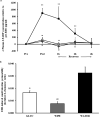Exertional-heat stress-associated gastrointestinal perturbations during Olympic sports: Management strategies for athletes preparing and competing in the 2020 Tokyo Olympic Games
- PMID: 32166105
- PMCID: PMC7053925
- DOI: 10.1080/23328940.2019.1597676
Exertional-heat stress-associated gastrointestinal perturbations during Olympic sports: Management strategies for athletes preparing and competing in the 2020 Tokyo Olympic Games
Abstract
Exercise-induced gastrointestinal syndrome (EIGS) is a common characteristic of exercise. The causes appear to be multifactorial in origin, but stem primarily from splanchnic hypoperfusion and increased sympathetic drive. These primary causes can lead to secondary outcomes that include increased intestinal epithelial injury and gastrointestinal hyperpermeability, systemic endotoxemia, and responsive cytokinemia, and impaired gastrointestinal function (i.e. transit, digestion, and absorption). Impaired gastrointestinal integrity and functional responses may predispose individuals, engaged in strenuous exercise, to gastrointestinal symptoms (GIS), and health complications of clinical significance, both of which may have exercise performance implications. There is a growing body of evidence indicating heat exposure during exercise (i.e. exertional-heat stress) can substantially exacerbate these gastrointestinal perturbations, proportionally to the magnitude of exertional-heat stress, which is of major concern for athletes preparing for and competing in the upcoming 2020 Tokyo Olympic Games. To date, various hydration and nutritional strategies have been explored to prevent or ameliorate exertional-heat stress associated gastrointestinal perturbations. The aims of the current review are to comprehensively explore the impact of exertional-heat stress on markers of EIGS, examine the evidence for the prevention and (or) management of EIGS in relation to exertional-heat stress, and establish best-practice nutritional recommendations for counteracting EIGS and associated GIS in athletes preparing for and competing in Tokyo 2020.
Keywords: Endurance; cytokine; endotoxin; epithelial; gastric emptying; malabsorption; peristalsis; thermoregulation.
© 2019 Informa UK Limited, trading as Taylor & Francis Group.
Figures







Similar articles
-
Gastrointestinal Assessment and Therapeutic Intervention for the Management of Exercise-Associated Gastrointestinal Symptoms: A Case Series Translational and Professional Practice Approach.Front Physiol. 2021 Sep 7;12:719142. doi: 10.3389/fphys.2021.719142. eCollection 2021. Front Physiol. 2021. PMID: 34557109 Free PMC article.
-
The increase in core body temperature in response to exertional-heat stress can predict exercise-induced gastrointestinal syndrome.Temperature (Austin). 2023 May 24;11(1):72-91. doi: 10.1080/23328940.2023.2213625. eCollection 2024. Temperature (Austin). 2023. PMID: 38577295 Free PMC article.
-
Prehospital management of exertional heat stroke at sports competitions: International Olympic Committee Adverse Weather Impact Expert Working Group for the Olympic Games Tokyo 2020.Br J Sports Med. 2021 Dec;55(24):1405-1410. doi: 10.1136/bjsports-2020-103854. Epub 2021 Apr 22. Br J Sports Med. 2021. PMID: 33888465 Free PMC article.
-
Looking ahead of 2021 Tokyo Summer Olympic Games: How Does Humid Heat Affect Endurance Performance? Insight into physiological mechanism and heat-related illness prevention strategies.J Therm Biol. 2021 Jul;99:102975. doi: 10.1016/j.jtherbio.2021.102975. Epub 2021 Apr 22. J Therm Biol. 2021. PMID: 34420619 Review.
-
The Gastrointestinal Exertional Heat Stroke Paradigm: Pathophysiology, Assessment, Severity, Aetiology and Nutritional Countermeasures.Nutrients. 2020 Feb 19;12(2):537. doi: 10.3390/nu12020537. Nutrients. 2020. PMID: 32093001 Free PMC article. Review.
Cited by
-
Gastrointestinal Tolerance of Low, Medium and High Dose Acute Oral l-Glutamine Supplementation in Healthy Adults: A Pilot Study.Nutrients. 2020 Sep 27;12(10):2953. doi: 10.3390/nu12102953. Nutrients. 2020. PMID: 32992440 Free PMC article. Clinical Trial.
-
Sportomics method to assess acute phase proteins in Olympic level athletes using dried blood spots and multiplex assay.Sci Rep. 2022 Nov 18;12(1):19824. doi: 10.1038/s41598-022-23300-y. Sci Rep. 2022. PMID: 36400821 Free PMC article.
-
Performance and thermoregulation of Dutch Olympic and Paralympic athletes exercising in the heat: Rationale and design of the Thermo Tokyo study: The journal Temperature toolbox.Temperature (Austin). 2021 Jun 2;8(3):209-222. doi: 10.1080/23328940.2021.1925618. eCollection 2021. Temperature (Austin). 2021. PMID: 34485618 Free PMC article.
-
Impact of moderate environmental heat stress during running exercise on circulating markers of gastrointestinal integrity in endurance athletes.Physiol Rep. 2025 Apr;13(7):e70305. doi: 10.14814/phy2.70305. Physiol Rep. 2025. PMID: 40170530 Free PMC article.
-
Tokyo-2020ne, Temperature and time for reflection.Temperature (Austin). 2020 Aug 6;7(2):109-110. doi: 10.1080/23328940.2020.1784684. eCollection 2020. Temperature (Austin). 2020. PMID: 33015238 Free PMC article. No abstract available.
References
-
- Gill SK, Hankey J, Wright A, et al. The impact of a 24-hour ultra-marathon on circulatory endotoxin and cytokine profile. Int J Sports Med. 2015;36:688–695. - PubMed
-
- Gill SK, Teixeira A, Rama L, et al. Circulatory endotoxin concentration and cytokine profile in response to exertional-heat stress during a multi-stage ultra-marathon competition. Exerc Immunol Rev. 2015;21:114–128. - PubMed
-
- Costa RJS, Snipe R, Kitic C, et al. Systematic review: exercise-induced gastrointestinal syndrome–Implication for health and disease. Aliment Ther Pharmacol. 2017;46(3):246–265. - PubMed
-
- Engebretsen L, Soligard T, Steffen K, et al. Sports injuries and illnesses during the London Summer Olympic Games 2012. Br J Sports Med. 2013;47(7):407–414. - PubMed
Publication types
LinkOut - more resources
Full Text Sources
